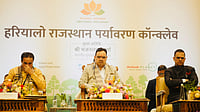In 2023, despite a slight drop in the total number of nuclear power plants worldwide, electricity generation from nuclear reactors increased by 2 percent. However, it still fell 58 terawatt-hours short of the levels seen in 2019, before the COVID-19 pandemic, and was 2 percent lower than its peak output in 2006, according to the 2024 Statistical Review of World Energy report by The Energy Institute.
When first developed in the 1950s and the 1960s, governments were excited about the unlimited potential of nuclear power. Nuclear reactors could harness the energy released during a nuclear fission to generate electricity for millions. With a single kilogram of Uranium yielding 20,000 as much energy as a kilogram of coal, it seemed like the future.
However, apprehensions around nuclear projects began to rise with the 1986 Chernobyl disaster that led to the largescale contamination of natural resources. In 2011, the Fukushima nuclear plant suffered damages due to tsunami, triggering fresh concerns regarding future investments in the nuclear energy sector. At that time, Japan shut down all of its reactors. However, Japan's investments into the sector has not stopped. The island country has reopened 12 nuclear power reactors since 2011 and is looking to build its nuclear capacity further.
Germany, on the other hand, decided to phase out nuclear power altogether. This resulted in the loss of 48GW of electric power generation globally between 2011 and 2020, reported the BBC.
Despite the challenges, global nuclear energy production has not completely come to a halt.
Unstoppable energy
Amid growing power demands, countries have embraced nuclear power production. India too has been significantly pushing to create nuclear energy with a goal to achieve 500 gigawatts (GW) of non-fossil fuel capacity by 2030. India is heavily depend on coal and other fossil fuels to meet its energy consumption needs. Nuclear power plant do not emit greenhouse gases while generating electricity. Considering that the energy sector accounts for a significant share of carbon dioxide (CO2) emissions per year, several industry experts feel that exploring nuclear potential might align with the world's efforts to tap into non-fossil based energy resources.
In this regard, Union Power Minister Shri Manohar Lal recently urged Indian states, that lack coal resources, to explore other nuclear-based power plant setups.
Other countries too are focusing on strengthening their nuclear energy capacities. South Korea recently scrapped its plans to phase out its large fleets of nuclear power stations over the next four decades, and will build more instead. And France has reversed plans to reduce its own reliance on nuclear energy, which provides 70 percent of its electricity. Instead, it wants to build up to eight new reactors. China, for instance, had 13 nuclear reactors in 2011 but now has 58 reactors with 29 under construction, as per the World Nuclear Association.
In Canada too, advancements are being made in the nuclear energy domain, with Westinghouse and Core Power joining hands to advance the design of a floating nuclear power plant using the eVinci microreactor and its heat pipe technology.
With advancements in artificial intelligence (AI), the demand for energy is expected to rise further as experts point out that AI-powered data centres are considered to be energy-intensive. Data centres, which currently consume 3.5 percent of US electricity, could exceed 9 percent by 2030, as per a BBC report.
To meet the growing power demands, Microsoft has reportedly signed a deal to reopen the Three Mile Island power station in Pennsylvania – the site of the worst nuclear accident in US history – while Google and Amazon have backed the development of Small Modular Reactors (SMRs) to support clean, efficient energy for technical infrastructure.



























